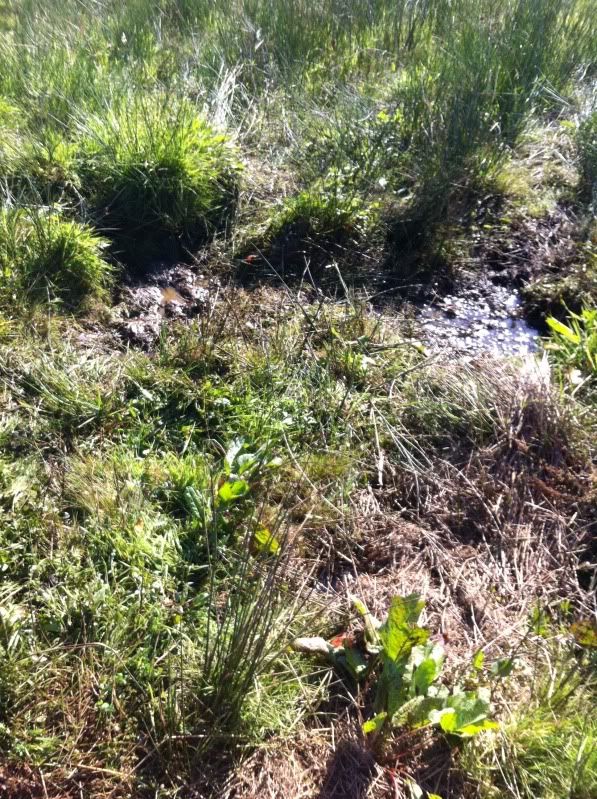On one of our visits to the property whilst in the process of buying it, the then owner showed us a book. Called "A Farmers Boy" it was brought to her attention by a friend who had noticed that it had a picture of her house on the front. It was written by a man who had grown up there during WW2 and contained a biography of his time there (and his family's subsequent departure). The owner, Jenny, told us that whoever ended up buying the house would find a copy of the book waiting for them. From that day onwards I was determined to read the book but positive that I would only do so once I received our free copy with the house.
True to her word, when we finally entered the now empty house on the day of completion, there was a copy of the book (next to a bottle of Champagne and a card).
We moved in the first week of September 2013 when the UK was enjoying a few weeks of sunny weather. It seemed hard to believe after the dreadful Winter 2013/14 that we could have a day without rain. I had noticed, however, that my dogs, whilst exploring the paddocks, had located some patches of stagnant water. Bearing in mind it hadn't rained for a few weeks, it was obvious there was a source nearby.
It was whilst reading the first few chapters of the book, wherein the author describes the property, much as I am attempting to do, that I read mention of a spring in the upper paddock (although he referred to the field by a different name, the farm of his youth having had far greater reaches than the portion we occupy). His description was accurate enough to make me start investigating so the following day I resolved to make a start in locating the spring.
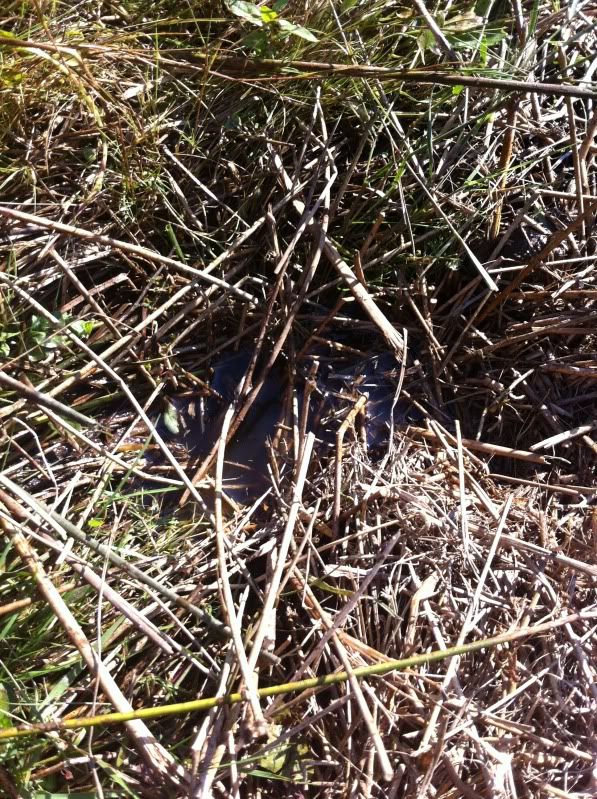 |
| More standing water |
A cursory inspection of the land showed no obvious source but there was an extremely boggy patch in the position he had described. I stuck a pole into the soil where I gauged an approximate centre to be and marked out a circular area of 5m diameter. With the help of my new spade, I began to dig...
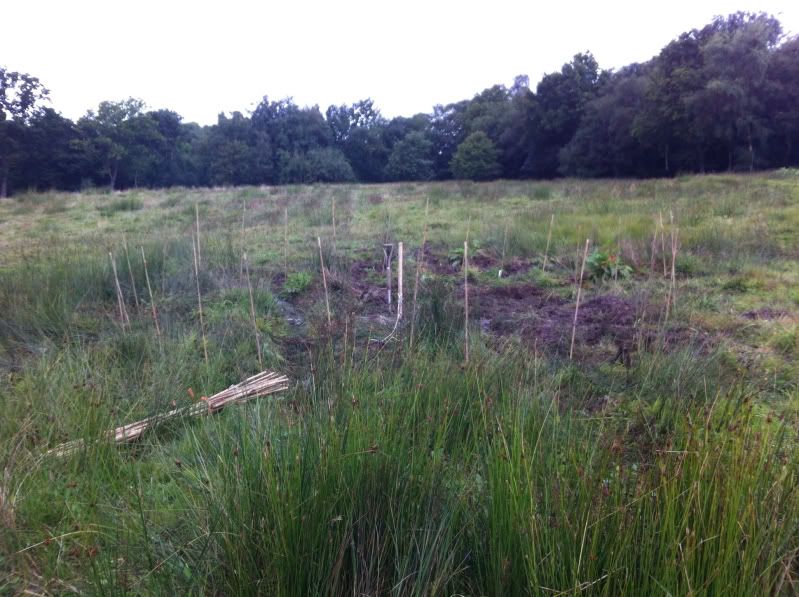 |
| Bamboo henge! |
A few days/weeks passed and the hole I had begun digging was getting larger and larger.
There were places where the water was seeping through the soil and collected in the base but I had yet to find any evidence or a spring head. It was almost completely by chance that I began to excavate a particularly soggy spot by hand (having broken my spade handle in trying to lever out a heavy chunk of root filled sod) that I stumbled across a plastic pipe, buried about 2 feet down. Subsequent investigation with drain rods led to a stoppage some 8 feet up the pipe but once I had dug sufficient clearance, there was a constant stream of water trickling from this pipe. As luck would have it, the pipe entered by circle right on the edge but didn't lead anywhere and so the water just soaked into the soil and made it boggy. The rotting vegetation made the whole area smell of cow manure, even though no cattle had been grazed there to the best of my knowledge.
 |
| The pond grows |
There were places where the water was seeping through the soil and collected in the base but I had yet to find any evidence or a spring head. It was almost completely by chance that I began to excavate a particularly soggy spot by hand (having broken my spade handle in trying to lever out a heavy chunk of root filled sod) that I stumbled across a plastic pipe, buried about 2 feet down. Subsequent investigation with drain rods led to a stoppage some 8 feet up the pipe but once I had dug sufficient clearance, there was a constant stream of water trickling from this pipe. As luck would have it, the pipe entered by circle right on the edge but didn't lead anywhere and so the water just soaked into the soil and made it boggy. The rotting vegetation made the whole area smell of cow manure, even though no cattle had been grazed there to the best of my knowledge.
A note on soil substructure:
A spring normally appears when water meets an impenetrable surface, whether clay, rock or something else. When this layer gets close to the surface, which would normally be on a steep slope, the water bursts has nowhere to go but out of the ground which is where one finds a spring. In many cases, the underlying structure forms a channel that is sufficient to concentrate the water to a single point but in my case it's not quite so simple. The top layer is composed if thickly rooted peat. It's sodden and heavy and difficult to dig out. Below this foot-thick layer (and I apologise now for mixing my units in this blog but that's the English way!) there is some fairly sandy soil for about another 12 inches. Below this, and forming the impenetrable base layer, there is a substance known as "greensand". This is light grey in appearance, and superficially resembles clay in texture until one realises how it crumbles rather than squidges under pressure.
Drying out a portion of this leaves one with extremely fine sand which is enough to clog a filter without being quite as impervious as proper clay. As far as I can tell, because this substance isn't the perfect barrier as you might find with clay, the spring doesn't form from a single point but tends to seep out over a larger area. I will perform a "Mason jar test" in due course
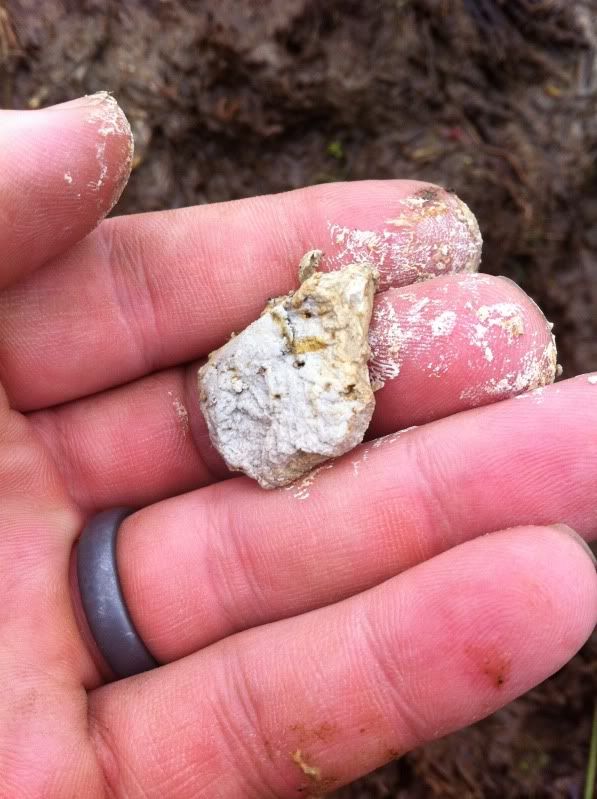 |
| A lump of the sand... |
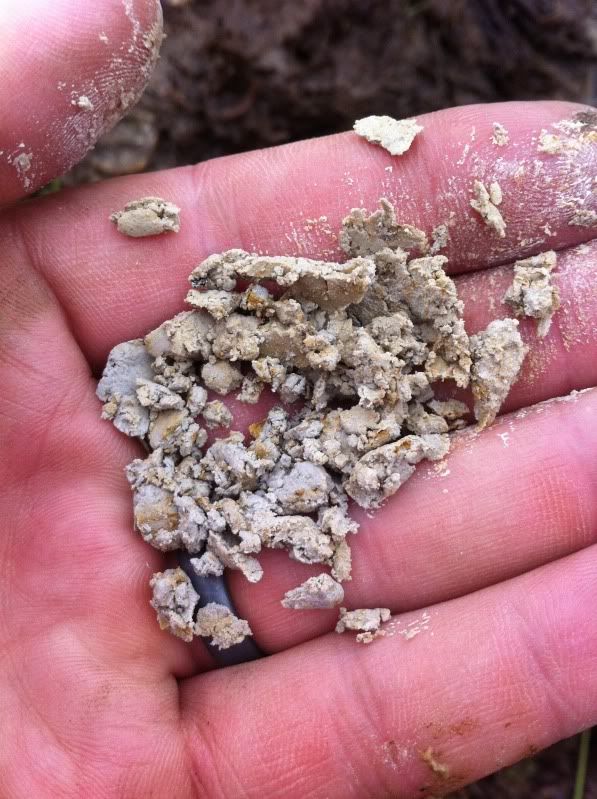 |
| ...which crumbles, unlike clay |
Drying out a portion of this leaves one with extremely fine sand which is enough to clog a filter without being quite as impervious as proper clay. As far as I can tell, because this substance isn't the perfect barrier as you might find with clay, the spring doesn't form from a single point but tends to seep out over a larger area. I will perform a "Mason jar test" in due course
The book mentions that the author's father placed a wooden barrel over the spring to stop contamination from leaves etc. There is also note of a metal pipe running down to a storage tank. My diggings uncovered various pieces of wood, some of which were long enough to positively identify as barrel staves.
I also found the original iron pipe, rusted solid and it was broken whilst being dug up. I also found several sections of ceramic land drain (short lengths of terracotta pipe that are laid end-to-end, the gaps in-between serving as an entry for excess water in the soil). I followed these the best I could until they came to an end about 2m outside my 5m circle. They were all clogged with fine sand and several had been crushed or moved out of line. Whether they originally extended further down the hill, I don't know although it was confirmed to me in correspondence with the author of the book, Robin Armstrong Brown, that his father had laid them. There was no sign of the metal tank, although there is a zinc coated water tank behind one of the stables which could have been of a similar type.
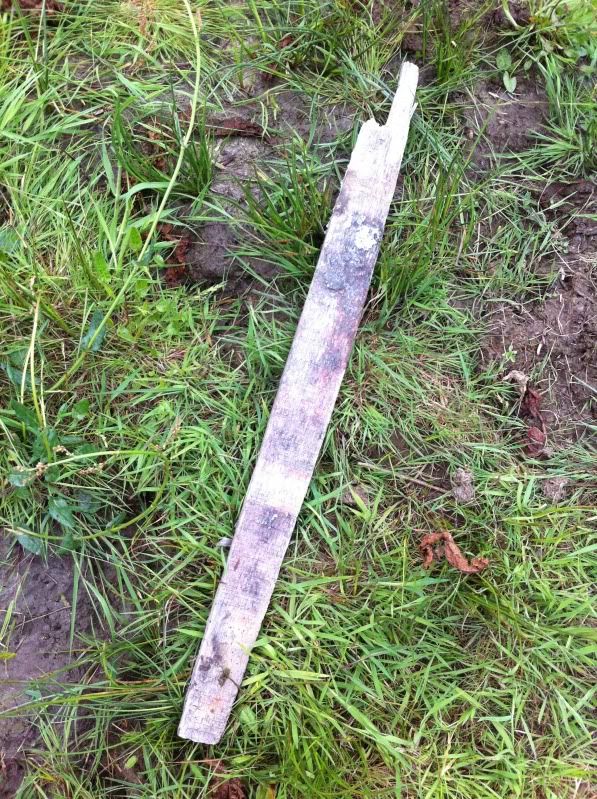 |
| Barrel stave |
I also found the original iron pipe, rusted solid and it was broken whilst being dug up. I also found several sections of ceramic land drain (short lengths of terracotta pipe that are laid end-to-end, the gaps in-between serving as an entry for excess water in the soil). I followed these the best I could until they came to an end about 2m outside my 5m circle. They were all clogged with fine sand and several had been crushed or moved out of line. Whether they originally extended further down the hill, I don't know although it was confirmed to me in correspondence with the author of the book, Robin Armstrong Brown, that his father had laid them. There was no sign of the metal tank, although there is a zinc coated water tank behind one of the stables which could have been of a similar type.
The plastic pipe, which was obviously a much later addition from a time after the book ended (I estimate some time in the 1980's - it's metric, 100mm) and the terracotta pipes (2") looked like they converged at the same spot. As I mentioned before, the plastic pipe was blocked further up. I duly dug down to find the other end and eventually uncovered it. It led to a load of rubble, mainly red bricks, and I am led to believe that a previous owner had most likely dug out a large area and backfilled it with rubble to stop it silting up and piped the excess off. For whatever reason, the whole area has been filled and levelled but without a full path for the water down to one of the ditches it has resulted in much of the paddock becoming a quagmire.
I elected to excavate the entire circle into a pond which would form a convenient place for the dogs to swim on a hot day as well as providing an alternative water source for the house, should we need it. My plan is to pipe the overflow down into the ditch which would be dammed further downstream. The overflow from this dam would then be piped into the pond in the lower paddock, which would be subsequently enlarged, to an acre or so, providing a picturesque and useful lake which could be stocked with fish or waterfowl.
A quick calculation after a period of fairly heavy rain showed that the outflow from the pipe was aroudn 3,000 gallons a day - this is likely to fall during the summer but if I dig the entire 5m circle to 2 feet deep, the pond will only hold about 2,700 gallons, which means it should fill up in a day:
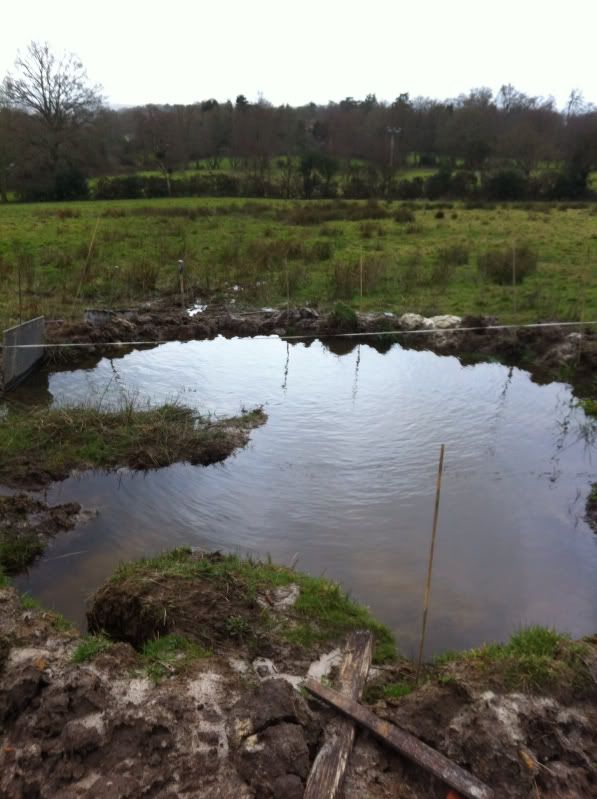 |
| Pretty full |
The above picture shows the pond partially filled. On the left of the picture is a piece of board that I was using as a temporary dam. Behind this I've started digging a trench (following the line of the white tape you can just see) - this will form the overflow into the ditch.
Due to the amount of rotting vegetation, at the moment the pond does tend to get covered in foam, caused by DOC (dissolved organic carbon). It's a bit unsightly, but completely natural and once I get some aquatic plants/animals in there, I should be able to keep the water clear:
Due to the amount of rotting vegetation, at the moment the pond does tend to get covered in foam, caused by DOC (dissolved organic carbon). It's a bit unsightly, but completely natural and once I get some aquatic plants/animals in there, I should be able to keep the water clear:
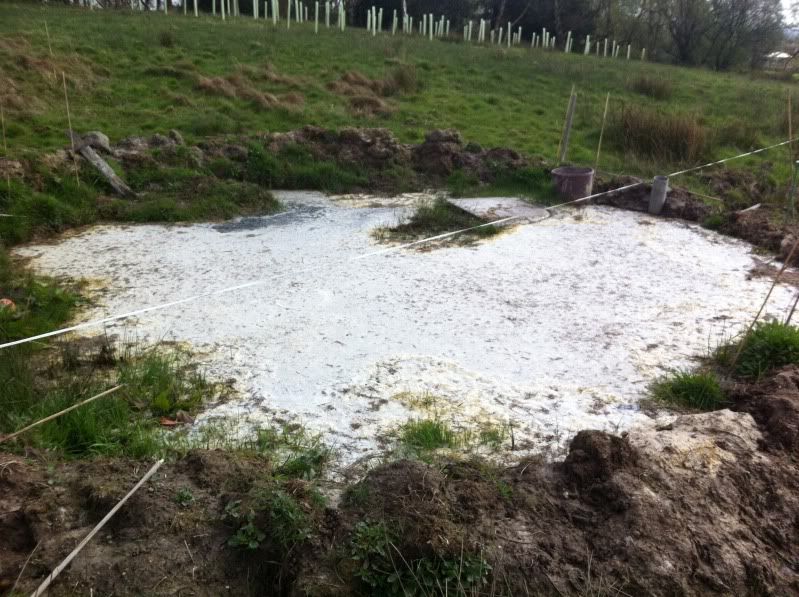 |
| DOC - dissolved organic carbon foam |
Because the pond is a work in progress, and I have planted a lot of tree down the hill, I needed a way to drain the pond so I can deepen it and water the plants underneath. With this in mind, I buried a piece of plastic drain pipe with a cap on it.
Unscrewing the cap causes the entire contents of the pond to rush out in a torrent, taking a lot of mud with it, that gets deposited into the paddock below. I've also dumped some weeds into the water to drown them with the hope that is turns the entire pond into a big tank of compost tea!
It also helps to send some helpers in to stir the silt up before draining it:
 |
| Unscrew me to unleash Hell! |
Unscrewing the cap causes the entire contents of the pond to rush out in a torrent, taking a lot of mud with it, that gets deposited into the paddock below. I've also dumped some weeds into the water to drown them with the hope that is turns the entire pond into a big tank of compost tea!
It also helps to send some helpers in to stir the silt up before draining it:
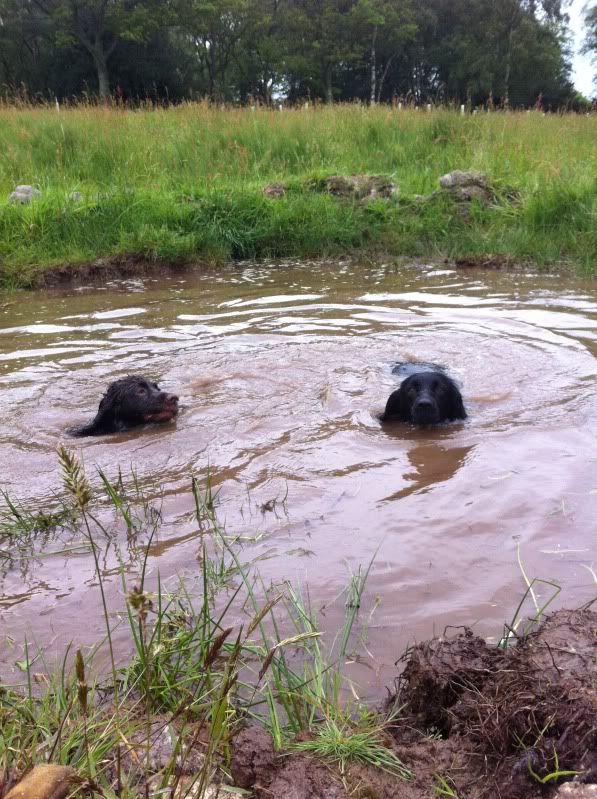 |
| As Dog intended |
